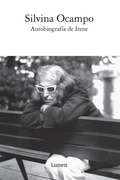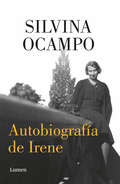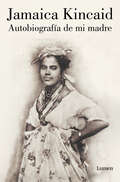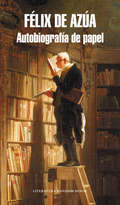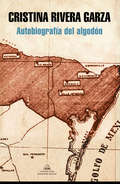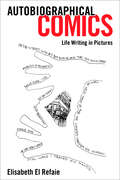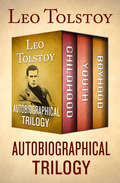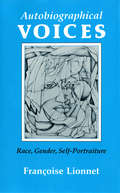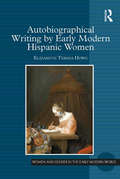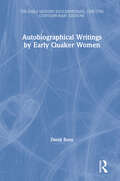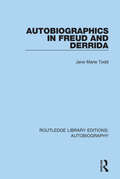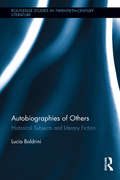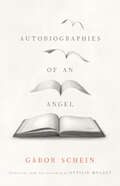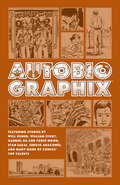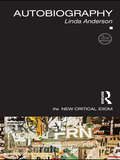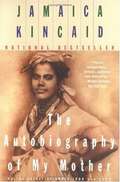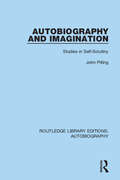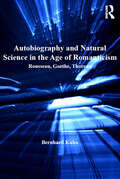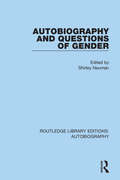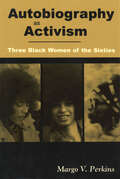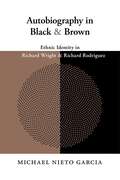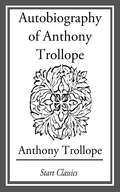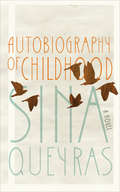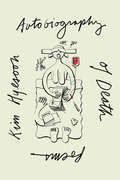- Table View
- List View
Autobiografía de Irene
by Silvina OcampoEsta nueva edición incluye cinco cuentos y se agrega el argumentoinédito que la autora escribió para una versión cinematográfica nuncarealizada de «El impostor». «Es una obra extrema, cuyos paralelismos máscercanos en la literatura nacional parecen ser "Ficciones", de JorgeLuis Borges, y "La trama celeste", de Adolfo Bioy Casares». En «Autobiografía de Irene» son convocadas las promesas de la mejorliteratura -una narración ceñida y diáfana, el vuelo de la imaginación asus anchas- y Silvina Ocampo logra que se cumplan. En estos cincocuentos, en los que se explora la identidad, la mentira, la muerte, lamelancolía, los sueños, las certidumbres e incertidumbres acerca de loque ocurrió o no ocurrió, las líneas temáticas se confunden en la calmapara volver repentinamente con toda violencia.
Autobiografía de Irene
by Silvina OcampoEntre la Roma antigua, una ciudad china o la pampa bonaerense, en estos cuentos la autora profundiza sus preguntas sobre la identidad, la mentira, el rencor, la muerte, la melancolía y los sueños. Publicada por primera vez en 1948, Autobiografía de Irene cumple las promesas de la mejor literatura: una narración ceñida y diáfana, un estilo de económica precisión, el vuelo de la imaginación a sus anchas. En estos cinco cuentos, que transcurren en escenarios tan diversos como la Roma antigua, una ciudad de China o el campo de la provincia de Buenos Aires, Silvina Ocampo explora la identidad, la mentira, el rencor, la muerte, la melancolía, los sueños, las certidumbres e incertidumbres acerca de lo que ocurrió o no ocurrió: a menudo, las líneas temáticas se confunden en la calma y un inusitado esplendor comparece con toda su violencia. La fascinación que el más extenso de los relatos, "El impostor", ha despertado en guionistas y directores de cine no es casual: esta historia poblada de claves equívocas nos precipita en una ensoñación diurna donde la realidad y sus artificios establecen una fantasmagoría inolvidable. Esta nueva edición incluye el argumento inédito que la autora escribió para una versión cinematográfica, nunca realizada, de esa límpida y ambigua nouvelle. «De las palabras que podrían definirla, la más precisa es, creo, genial.»Jorge Luis Borges
Autobiografía de mi madre
by Jamaica KincaidUna novela «que deja huellas imborrables en quien la lee» (Babelia) y obtuvo el Premio Anisfield-Wolf, por la candidata al Nobel y ganadora de los premios Femina Étranger, American Book Award, Dan David Prize y The Paris Review Hadada Award, traducida a veintidós idiomas, alabada por la crítica y autores como Derek Walcott y Susan Sontag. «Impactante. Escrita con elegancia y delicadeza, es también inhumana».Cathleen Schine, The New York Times «Kincaid es una de las pocas escritoras angloparlantes actuales que querría leer siempre».Susan Sontag Mi madre murió en el momento en que yo nací, y así, durante toda mi vida, no hubo nada que se interpusiera entre yo y la eternidad; a mi espalda había siempre un viento negro y sombrío. Así comienza el relato de vida de Xuela, que nace a principios del siglo XX en la isla de Dominica,en las Antillas y que, a sus setenta años, rememora los eventos de una existencia marcada por una madre a la que nunca conoció y por los hijos que nunca tuvo. Hija de una caribeña que muere poco después de dar a luz y de un afroescocés que la entrega al cuidado de una lavandera, Xuela intenta encontrar su camino en un mundo huérfano y con la herencia opresiva de la dominación colonial. Cuando alcanza la edad escolar, su padre la manda a la escuela, donde sufre la discriminación de su profesora. Por este motivo, su padre decide llevarla con él y su nueva esposa, quien comienza a atacarla por percibirla como una competidora para la estabilidad económica de sus propios hijos. Cuando Xuela cumple quince años, su padre la envía a vivir con unos conocidos, el matrimonio LaBatte. Al observarlos, Xuela aprenderá la naturaleza dependiente de las relaciones entre hombres y mujeres, y empezará a sufrir las insinuaciones del señor LaBatte. «Poderosa, perturbadora y hechizante» (The New York Times), Autobiografía de mi madre es una de las mejores novelas de Jamaica Kincaid, galardonada con el Premio Anisfield-Wolf Book. Reseñas:«Hipnótica, desgarradora y profundamente metafórica [...]. Una historia extraordinaria».Publishers Weekly «Un libro desesperado y corrosivo, un texto que lastima con delicadeza, que hace pensar, y lo hace desde su propia autobiografía. [...] Kincaid es implacable para describir su dolor, su odio, la miseria, los estragos del colonialismo. [...] Un texto que deja huellas imborrables en quien lo lee».Babelia (El País), «Lecturas para la cuarentena» «Impactante. Escrita con elegancia y delicadeza, es también inhumana, y lo es sin paliativos. Una meditación realmente dura sobre la vida y una de las prosas más bellas que podemos encontrar en la ficción contemporánea [...] Pura y abrumadora, Autobiografía de mi madre es una fábula brillante y nihilista».Cathleen Schine, The New York Times «Feroz, hechizante. [...] Lírica. [...] Poderosa y perturbadora».Michiko Kakutani, The New York Times «Kincaid —una estilista siempre elegante— convierte esta historia de una mujer sencilla en algo extraordinario. [...] Una prosa rica en matices poéticos. [...] Un relato de supervivencia inolvidable».San Francisco Chronicle Book Review «Un libro que nos atormenta y nos deslumbra. [...] Kincaid escribe como un ángel: con una lucidez y precisión envidiables».Boston Sunday Globle «Una historia bella y dura [...]. Un libro esculpido a fuego, que tiene tanto de hechizo como de novela».Richard Eder, Los Angeles Times «No da respiro. [...] El colonialismo, la negación de la cultura local y la relación entre madres e hijas son ejes de una escritura intensa y erótica».Clarín «Un texto clave en el panorama de la literatura poscolonial caribeña [...]
Autobiografía de papel
by Félix de AzúaComo complemento a su libro Autobiografía sin vida, en Autobiografía de papel, Félix de Azúa nos muestra las necesarias reflexiones sobre la condición de escritor, la política y la sociedad. Tras varias décadas de intensa dedicación al oficio de la literatura, Félix de Azúa vuelve la mirada a las ruinas del siglo pasado para narrar su experiencia a través de los géneros, una peculiar autobiografía donde no importa tanto el sujeto como el caso. Con implacable lucidez, a lo largo de unas páginas vibrantes, llenas de iluminaciones, Azúa revisita sus distintas edades literarias, desde la iniciación en el lenguaje sagrado de la poesía para entrar luego en la democracia de la novela y de ahí al laberinto del ensayo, con una coda dedicada al periodismo como género dominante de nuestros días. El relato de su propia trayectoria le permite a Azúa, además, construir una lectura, personal y contundente, del curso de la literatura a lo largo del siglo XX. A la manera de un autorretrato donde más que una fisonomía se trasluciera la genealogía de un tiempo, de una idea de la literatura y de una forma, tal vez agónica, de interrogar al mundo, Félix de Azúa ofrece en este libro un testimonio único, de una belleza espectral, que a su vez constituye un estímulo para enfrentarnos a las urgentes transformaciones de nuestro tiempo.
Autobiografía del algodón
by Cristina Rivera Garza"Autobiografía del algodónAutobiografía algodón dota de un nuevo y extraordinario significante al territorio de la frontera norte de México, que aquí se erige majestuoso sobre el movimiento nómada y las rutas de recuerdos." Yásnaya Elena Aguilar Indagar sobre el origen personal es abrir la puerta a muchas preguntas, a silencios y respuestas impensadas que a veces terminan por ser un revés de la memoria. En Autobiografía del algodón, Cristina Rivera Garza sigue con curiosidad y asombro los pasos de aquellos hombres y mujeres que habitan su pasado familiar, obreros y campesinos que trabajaron la tierra que ahora conforma la frontera entre Tamaulipas y Texas, una región que alcanzó un alto nivel económico, social y cultural gracias al sistema de siembra del algodón. Es así que esta novela es, además de íntima, un reencuentro con el territorio. O un desencuentro, debido a la migración, deportación, expulsión y repatriación de aquellos campesinos algodoneros que, tras el fracaso del sistema, dejaron libre su espacio, antes símbolo de progreso, hoy ocupado por la llamada guerra contra el narco.
Autobiographical Comics: Life Writing in Pictures
by Elisabeth El RefaieA troubled childhood in Iran. Living with a disability. Grieving for a dead child. Over the last forty years the comic book has become an increasingly popular way of telling personal stories of considerable complexity and depth. In Autobiographical Comics: Life Writing in Pictures, Elisabeth El Refaie offers a long overdue assessment of the key conventions, formal properties, and narrative patterns of this fascinating genre. The book considers eighty-five works of North American and European provenance, works that cover a broad range of subject matters and employ many different artistic styles. Drawing on concepts from several disciplinary fields—including semiotics, literary and narrative theory, art history, and psychology—El Refaie shows that the traditions and formal features of comics provide new possibilities for autobiographical storytelling. For example, the requirement to produce multiple drawn versions of one's self necessarily involves an intense engagement with physical aspects of identity, as well as with the cultural models that underpin body image. The comics medium also offers memoirists unique ways of representing their experience of time, their memories of past events, and their hopes and dreams for the future. Furthermore, autobiographical comics creators are able to draw on the close association in contemporary Western culture between seeing and believing in order to persuade readers of the authentic nature of their stories.
Autobiographical Trilogy: Childhood, Youth, and Boyhood (Autobiographical Trilogy #1)
by Leo TolstoyThese three connected early novels from the author of War and Peace and Anna Karenina form an intimate portrait of Russian youth. Begun when Leo Tolstoy was just twenty-three years old and stationed at a remote army outpost in the Caucasus Mountains, his work known as the Autobiographical Trilogy would win immediate fame and critical praise years before works like War and Peace and Anna Karenina would bring him to the forefront of Russian literature. Here is the story of a young man—the son of a wealthy Russian landowner—who describes in exquisite detail both the landmarks and minutiae of his life, from his interactions with other people to observations on the nature of both himself and the world around him. As told by Nikolenka from the ages of ten to sixteen, it is a brilliantly insightful recollection of the formative years of life—with all of the ebullient joy and crushing heartbreak it entails—that still resonates in our modern world. Originally planned as a four-part series of novels tentatively called the &“Four Epochs of Growth,&” the completed works together form a remarkable expression of the great Russian novelist&’s early voice and vision, which would ultimately make him one of the most renowned and revered authors in literary history. This ebook has been professionally proofread to ensure accuracy and readability on all devices.
Autobiographical Voices: Race, Gender, Self-Portraiture (Reading Women Writing)
by Françoise LionnetAdopting a boldly innovative approach to women’s autobiographical writing, Françoise Lionnet here examines the rhetoric of self-portraiture in works by authors who are bilingual or multilingual or of mixed races or cultures. Autobiographical Voices offers incisive readings of texts by Zora Neale Hurston, Maya Angelou, Marie Cardinal, Maryse Condé, Marie-Thérèse Humbert, Augustine, and Nietzsche.
Autobiographical Writing by Early Modern Hispanic Women
by Elizabeth Teresa HoweWomen’s life writing in general has too often been ignored, dismissed, or relegated to a separate category in those few studies of the genre that include it. The present work addresses these issues and offers a countervailing argument that focuses on the contributions of women writers to the study of autobiography in Spanish during the early modern period. There are, indeed, examples of autobiographical writing by women in Spain and its New World empire, evident as early as the fourteenth-century Memorias penned by Doña Leonor López de Cordóba and continuing through the seventeenth-century Cartas of Sor Juana Inés de la Cruz. What sets these accounts apart, the author shows, are the variety of forms adopted by each woman to tell her life and the circumstances in which she adapts her narrative to satisfy the presence of male critics-whether ecclesiastic or political, actual or imagined-who would dismiss or even alter her life story. Analyzing how each of these women viewed her life and, conversely, how their contemporaries-both male and female-received and sometimes edited her account, Howe reveals the tension in the texts between telling a ’life’ and telling a ’lie’.
Autobiographical Writings by Early Quaker Women (The Early Modern Englishwoman, 1500-1750: Contemporary Editions)
by David BooyWhile writings by early modern Quaker women have been discussed and quoted fairly extensively, relatively few of their texts are readily or widely available. The chief purpose of this edition is to rectify this state of affairs in one central area - that of autobiographical writing. The edition contains substantial excerpts from a range of self-writings by Quaker women, composed between the 1650s and circa 1710: letters, testimonies, memoirs, accounts of spiritual development, narratives of persecution and imprisonment. Six of the texts have been freshly edited from manuscripts (including Mary Penington's A Brief Account); the others have been transcribed from the first printed editions. In his general introduction to the volume, the editor sketches the history of the Quaker movement from the 1650s to the early 1700s, and considers the role of female Quakers during the first and second phases of the movement. The introduction also surveys the types and purposes of autobiographical writings produced by female Friends, and relates these writings to key Quaker ideas, concerns and practices regarding the inner light, scripture, testimony, plain speaking, friendship, gender and community. Booy indicates the wider context of the development of autobiographical writing during the seventeenth century, and discusses briefly issues to do with the construction of the self in writing. Each text is prefaced by a substantial headnote providing biographical and historical information. Footnotes supply biblical and other references, and gloss unfamiliar or specialist vocabulary. The volume includes a comprehensive bibliography of primary and secondary materials. The edition is aimed at all those interested in the history of the Quakers, whether they be scholars in the fields of religious, cultural and women's studies, or of history and literature generally.
Autobiographics in Freud and Derrida (Routledge Library Editions: Autobiography #9)
by Jane Marie ToddOriginally published in 1990. This uniquely fascinating study approaches the problem of autobiography from two directions: first assessing theories of the self, consciousness and language developed by both Freud and Derrida; second through the reading of the autobiographical aspects of their writings. The book begins with looking at the issue of making sense of a life by means of representation, through autobiography, within the field of psychological phenomena – screen memories, mourning, obsession, hysteria, transference. Part 1 focuses on Freud’s case histories and psychoanalysis being used to make a narrative of behaviour in language. Part two considers Freud’s own Interpretation of Dreams and its autobiographical nature. Part 3 examines intellectual movements such as phenomenology, speed act theory and structuralism while Parts 4 and 5 turn to Derrida’s use of autobiography as self-criticism and his debt to Freud.
Autobiographies of Others: Historical Subjects and Literary Fiction (Routledge Studies in Twentieth-Century Literature)
by Lucia BoldriniIn this volume, Boldrini examines "heterobiography"—the first-person fictional account of a historic life. Boldrini shows that this mode is widely employed to reflect critically on the historical and philosophical understanding of the human; on individual identity; and on the power relationships that define the subject. In such texts, the grammatical first person becomes the site of an encounter, a stage where the relationships between historical, fictional and authorial subjectivities are played out and explored in the ‘double I’ of author and narrating historical character, of fictional narrator and historical person. Boldrini considers the ethical implications of assuming another’s first-person voice, and the fraught issue of authorial responsibility. Constructions of the body are examined in relation to the material evidence of the subject’s existence. Texts studied include Malouf’s An Imaginary Life, Carey’s True History of the Kelly Gang, Ondaatje’s The Collected Works of Billy the Kid, Adair’s The Death of the Author, Banti’s Artemisia, Vázquez Montalbán’s Autobiografía del general Franco. Also discussed, among others: Yourcenar’s Memoirs of Hadrian, Tabucchi’s The Last Three Days of Fernando Pessoa, Giménez-Bartlett’s Una habitación ajena (A Room of Someone Else’s).
Autobiographies of an Angel: A Novel (The Margellos World Republic of Letters)
by Gabor ScheinAn unflinching narrative of family history in Hungary&’s Jewish community and the nation&’s deep complicity in the Holocaust Born in 1723 in a small German town, Johann Klarfeld is thirteen when his father dies. He is taken in by a kind Italian painter to live with him and his daughter in The Hague. But the daughter, beautiful and blind, has a secret. Two centuries later, Berta Jósza is born during World War II in a village in northern Hungary. The daughter of a police officer, Berta watches chaos unfold through her father&’s eyes, from the plundering of the possessions of murdered Jews to the carnage of the 1956 Revolution. When she happens upon an enigmatic autobiography in a secondhand bookshop, she can&’t shake the sense that she somehow knows the author. Lyrical and haunting, this is an unforgettable story about the spirit of history and the individual fates that make up the whole—the entwinements of the past and their unshakable hold on the present.
Autobiographix (Second Edition)
by Will Eisner Fabio Moon Stan Sakai Gabriel Ba William StoutA premium collection demonstrating the effectiveness of the comics medium for telling the most personal of stories--the autobiography.Showcasing some of the first published autobiographical stories from living-legend artists, mainstream greats, and young "indie" up-and-comers!Featuring stories by Will Eisner, William Stout, Gabriel Bá and Fábio Moon, Stan Sakai, Sergio Aragonés, and many more of comics' top talent!
Autobiography (The New Critical Idiom)
by Linda AndersonIf every writer necessarily draws on their own life, is any writing outside the realm of ‘autobiography’? The new edition of this classic guide is fully updated to include: developments in autobiographical criticism, highlighting major theoretical issues and concepts different forms of the genre from confessions and narratives to memoirs and diaries uses of the genre in their historical and cultural contexts major autobiographical writers including St Augustine, Bunyan, Boswell, Rousseau and Wordsworth, alongside non-canonical autobiographies by women twentieth-century autobiography including women's writing, black and postcolonial writing, and personal criticism a new chapter on narrative and new material examining recent trends in autobiography such as blogs, the popularity of literary memoirs and recent developments in theory on testimonial writing. Combining theoretical discussion with thought-provoking readings of major texts, this is the ideal introduction to the study of a fascinating genre.
Autobiography Of My Mother
by Jamaica KincaidKincaid's new and long-awaited novel is a powerful and unforgettable story of loss, longing, loving, and survival that resonants with the proud insurgence of the human will. The story of Xuela, whose mother dies at the moment she is born, presents "an indeliable portrait of an angry woman" (New York Times) "most comparable, perhaps, to Camus' The Stranger" (Washington Post Book World).
Autobiography and Imagination: Studies in Self-scrutiny (Routledge Library Editions: Autobiography #8)
by John PillingOriginally published in 1981. This book looks at the autobiographical work of nine twentieth-century writers – Henry Adams, Henry James, W. B. Yeats, Boris Pasternak, Leiris, Jean-Paul Sartre, Vladimir Nabokov, Henry Green and Adrian Stokes. The author argues that often the writer has shaped his life through his craft, coming to understand the pattern of his own existence through the formalism of language. In each case the writer stamps his personality on the work by mean of a distinctive verbal surface whose discipline enables him to evade narrow egotism and forces both reader and writer into an act of collaboration and corroboration. Written at a time when criticism was turning to focus on the relation between the reader and the text, this study added a provocative dimension to the debate and is still an important read today.
Autobiography and Natural Science in the Age of Romanticism: Rousseau, Goethe, Thoreau
by Bernhard KuhnSet against the backdrop of a rapidly fissuring disciplinary landscape where poetry and science are increasingly viewed as irreconcilable and unrelated, Bernhard Kuhn's study uncovers a previously ignored, fundamental connection between autobiography and the natural sciences. Examining the autobiographies and scientific writings of Rousseau, Goethe, and Thoreau as representative of their ages, Kuhn challenges the now entrenched thesis of the "two cultures." Rather, these three writers are exemplary in that their autobiographical and scientific writings may be read not as separate or even antithetical but as mutually constitutive projects that challenge the newly emerging boundaries between scientific and humanistic thought during the Romantic period. Reading each writer's life stories and nature works side by side-as they were written-Kuhn reveals the scientific character of autobiographical writing while demonstrating the autobiographical nature of natural science. He considers all three writers in the context of scientific developments in their own times as well as ours, showing how each one marks a distinctive stage in the growing estrangement of the arts and sciences, from the self-assured epistemic unity of Rousseau's time, to the splintering of disciplines into competing ways of knowing under the pressures of specialization and professionalization during the late Romantic age of Thoreau. His book thus traces an unfolding drama, in which these writers and their contemporaries, each situated in an intellectual landscape more fragmented than the last, seek to keep together what modern culture is determined to break apart.
Autobiography and Questions of Gender (Routledge Library Editions: Autobiography #6)
by Shirley NeumanOriginally published in 1991. Addressing the ways in which the ideology of gender and its social construction determine autobiographical self-representations, the essays here consider several women’s works in the light of the social and historical conditions which enabled their production. Some examine diaries as a feminine form and ask about the ways in which thematic content such as childbirth can or cannot be represented in diaries and public discourse at different historical junctures. Others show the pressures of gender roles and how they have led to new genres in which self-representation is often a refraction of the representation of others. With the tools of gender theory, the representation of hermaphroditism, masculinity and male bodies is analysed and the ways in which gender intersects with racial, sexual and class ideologies is also looked at, in seeing autobiography as a form of agency in self-construction.
Autobiography as Activism: Three Black Women of the Sixties
by Margo V. PerkinsAngela Davis, Assata Shakur (a.k.a. JoAnne Chesimard), and Elaine Brown are the only women activists of the Black Power movement who have published book-length autobiographies. In bearing witness to that era, these militant newsmakers wrote in part to educate and to mobilize their anticipated readers. In this way, Davis's Angela Davis: An Autobiography (1974), Shakur's Assata (1987), and Brown's A Taste of Power: A Black Woman's Story (1992) can all be read as extensions of the writers' political activism during the 1960s. Margo V. Perkins's critical analysis of their books is less a history of the movement (or of women's involvement in it) than an exploration of the politics of storytelling for activists who choose to write their lives. Perkins examines how activists use autobiography to connect their lives to those of other activists across historical periods, to emphasize the link between the personal and the political, and to construct an alternative history that challenges dominant or conventional ways of knowing. The histories constructed by these three women call attention to the experiences of women in revolutionary struggle, particularly to the ways their experiences have differed from men's. The women's stories are told from different perspectives and provide different insights into a movement that has been much studied from the masculine perspective. At times they fill in, complement, challenge, or converse with the stories told by their male counterparts, and in doing so, hint at how the present and future can be made less catastrophic because of women's involvement. The multiple complexities of the Black Power movement become evident in reading these women's narratives against each other as well as against the sometimes strikingly different accounts of their male counterparts. As Davis, Shakur, and Brown recount events in their lives, they dispute mainstream assumptions about race, class, and gender and reveal how the Black Power struggle profoundly shaped their respective identities.
Autobiography in Black and Brown: Ethnic Identity in Richard Wright and Richard Rodriguez
by Michael Nieto GarciaRichard Wright was the grandson of slaves, Richard Rodriguez the son of immigrants. One black, the other brown, each author prominently displays his race in the title of his autobiography: Black Boy and Brown. Wright was a radical left winger, while Rodriguez is widely viewed as a reactionary. Despite their differences, Michael Nieto Garcia points out, the two share a preoccupation with issues of agency, class struggle, ethnic identity, the search for community, and the quest for social justice. Garcia&’s study, the first to compare these two widely read writers, argues that ethnic autobiography reflects the complexity of ethnic identity, revealing a narrative self that is bound to a visible ethnicity yet is also protean and free.These autobiographies, according to Garcia, exemplify the tensions and contradictions inherent in identity. In their presentation of the self we see the rejection not only of essentialized notions of ethnic authenticity but also of any conception of an ethnic self that is not also communally derived. The image reflected in the mirror of autobiography also reminds us that consciousness itself is altered by our reading, and that the construction of modern ethnicity is shaped to a considerable extent by print culture.
Autobiography of Anthony Trollope
by Anthony TrollopeIt may be well that I should put a short preface to this book. In the summer of 1878 my father told me that he had written a memoir of his own life. He did not speak about it at length, but said that he had written me a letter, not to be opened until after his death, containing instructions for publication. This letter was dated 30th April, 1876. I will give here as much of it as concerns the public: "I wish you to accept as a gift from me, given you now, the accompanying pages which contain a memoir of my life. My intention is that they shall be published after my death, and be edited by you. But I leave it altogether to your discretion whether to publish or to suppress the work;-and also to your discretion whether any part or what part shall be omitted. But I would not wish that anything should be added to the memoir. If you wish to say any word as from yourself, let it be done in the shape of a preface or introductory chapter." At the end there is a postscript: "The publication, if made at all, should be effected as soon as possible after my death." My father died on the 6th of December, 1882...
Autobiography of Childhood
by Sina QueyrasThe Combals are not unacquainted with death: they have never quite recovered from the loss of one of them in childhood. And now, on Valentine's Day, they are losing another. Guddy races to see her sister, Jerry and Bjarne avoid the phone and its news, Jean finds himself on a beach, and Annie fends off her mother's persistent questions about what's happening. And Therese tries to forgive them all before it's too late. As each is forced to face the news of Therese's impending death, their actions weave a nuanced portrait of a family, of the devastating reach of childhood grief.
Autobiography of Death
by Kim HyesoonKim Hyesoon’s poems “create a seething, imaginative under-and over-world where myth and politics, the everyday and the fabulous, bleed into each other” (Sean O’Brien, The Independent) The title section of Kim Hyesoon’s powerful new book, Autobiography of Death, consists of forty-nine poems, each poem representing a single day during which the spirit roams after death before it enters the cycle of reincarnation. The poems not only give voice to those who met unjust deaths during Korea’s violent contemporary history, but also unveil what Kim calls “the structure of death, that we remain living in.” Autobiography of Death, Kim’s most compelling work to date, at once reenacts trauma and narrates our historical death—how we have died and how we survive within this cyclical structure. In this sea of mirrors, the plural “you” speaks as a body of multitudes that has been beaten, bombed, and buried many times over by history. The volume concludes on the other side of the mirror with “Face of Rhythm,” a poem about individual pain, illness, and meditation.
